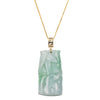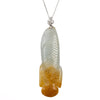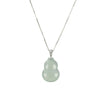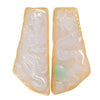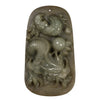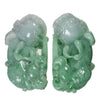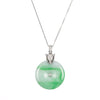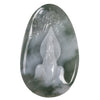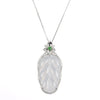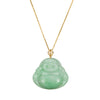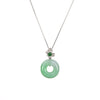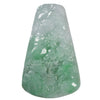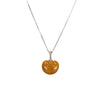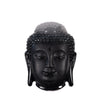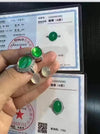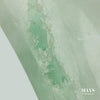Jade Pendants 101: Meanings and Symbolism
A Comprehensive Guide to Jade Pendants and their Meanings
What's Jade?
The term "jade" can denote two distinct minerals, Jadeite and Nephrite, depending on geographical location. In East Asian countries such as Burma (Myanmar), the term "jade" specifically refers to Jadeite. Conversely, in New Zealand, Nephrite is the mineral identified as jade. While both jades share some similarities, such as their mineral composition, they also have differences, including their chemical compositions, colors, and crystal structures.
Types of Jade Pendants
While jade pendants are typically carved solely out of jadeite or nephrite, some modern designs incorporate precious metals such as gold or silver with the carved jade. These gold jade pendants can also be assented with diamonds and other precious gemstones. At MAYS GEMS, we carry a large array of jade pendant designs; with gold, silver or just plain artisan hand-carved jadeite pendants.
Jade Pendant Designs from Various Cultures
Jade pendants boast an array of captivating designs that reflect the rich cultural tapestry of different societies. The diverse range of designs across cultures illustrates not only the aesthetic beauty of jade pendants but also the profound meanings and beliefs woven into each piece, making them not just accessories but cultural artifacts with stories to tell.
Chinese Culture
In Chinese culture, intricate carvings often depict auspicious symbols such as dragons, phoenixes, and mythical creatures like Pixiu. These designs convey messages of prosperity, protection, and good fortune.
Maroi Culture
Maori jade pendant designs from New Zealand, on the other hand, showcase symbols deeply rooted in their cultural heritage, such as the Hei-tiki, a stylized human figure, and other Maori motifs representing genealogy and spirituality.
Mesoamerican Culture
In ancient Mesoamerican cultures like the Maya and Aztecs, people crafted jade pendants featuring symbols and gods. These carvings carried deep religious and ritual meanings.
List of Jade Pendant Designs
Below is a comprehensive list of jade pendant designs from various cultures around the world. Click on the individual design names to learn about their meanings and symbolism.
Jade Bamboo
Bamboo, with its segmented structure, symbolizes continuous growth and prosperity, and it is also associated with the wish for a success in life’s changing circumstances. Its upward growth pattern is seen as a metaphor for continuous upward progress, making it a favorable symbol for financial success. Bamboo bends but does not break, symbolizing flexibility and adaptability. Wearing a jade bamboo pendant may represent the wearer's ability to adapt to changing circumstances and remain strong in the face of challenges. The growth pattern of bamboo, especially its rapid upward growth, can be seen as a symbol of spiritual growth and enlightenment too. The jade bamboo pendant may represent a personal journey towards spiritual development. In Chinese traditions, Jade Bamboo also has deep cultural roots that is often associated with Confucian virtues. Bamboo is known for its graceful and harmonious appearance. The jade bamboo pendant may symbolize a quest for balance, tranquility, and harmony in one's life.
| Symbolism: | Spiritual Growth, Prosperity, Flexibility and Adaptability, Harmony and Balance |
| Benefits: | Bring continuous growth financially or spiritually and provide flexibility to life's changes. |
| Cultural Context: | Chinese |
Jade Bean (Fudou)
In Chinese, the word for "bean" is "Fu Dou" and phonetically, it sounds like "Fu Shou," which means happiness, well-being, and longevity. This phonetic resemblance suggests a symbolic connection, implying a life associated with happiness and longevity. In China's historical context, jade carvings from the Ming and Qing dynasties often featured beans, regarded as symbols of good fortune symbolizing a bountiful harvest, prosperity, and fruitful labor. The number of beans also holds different meanings: four beans symbolize safety throughout the four seasons; three beans signify hitting three consecutive victories, with blessings, prosperity, and longevity arriving together; two beans represent the safety of both mother and child. During pregnancy, many women used to wear jade pendants with two beans to ensure the safety of mother and child.
| Symbolism: | Happiness, Longevity, Safety, Prosperity |
| Benefits: | Brings happiness, well-being and good fortune |
| Cultural Context: | Chinese |
Jade Fish
In Mandarin, the word for fish, "yu", sounds similar to the word for surplus or abundance, also "yu". This linguistic connection has led to the fish becoming a symbol of abundance and wealth in Chinese culture. A popular expression "Nian Nian You Yu," commonly used, particularly during the Spring Festival, translates to "May every year end with ample surplus." It's not surprising that fish is a must-have dish during Chinese New Year celebrations, as families seek to ensure prosperity for the coming year and incorporating fish symbols in New Year decorations is seen as a way to wish for abundance and surplus year after year. Wearing a jade fish pendant may symbolize a desire for abundance and prosperity.
| Symbolism: | Abundance, Surplus, Prosperity |
| Benefits: | Brings abundance and prosperity year after year |
| Cultural Context: | Chinese |
Jade Hulu
Wearing a Jade Hulu, also referred as a jade gourd or calabash, can carry various symbolic meanings. In traditional Chinese culture, the hulu is linked to health and longevity. Its shape is often likened to that of a vessel for containing the elixir of life, symbolizing the wish for a long and fulfilling life. The rounded shape of the hulu represents harmony and balance. It is associated with the idea of maintaining a harmonious and balanced life, both physically and spiritually. Sometimes hulu is considered a symbol of fertility, as its shape resembles a pregnant belly. Couples may wear jade hulu pendants with the hope of promoting fertility and the blessing of having children. The hulu is also associated with Taoist beliefs and spirituality. It is believed to have the ability to trap evil spirits and often used as a Feng Shui ornament.
| Symbolism: | Health and Longevity, Harmony and Balance, Fertility, Protection |
| Benefits: | Brings good health and a long life |
| Cultural Context: | Chinese |
Jade Dragon and Phoenix
A Jade Dragon and Phoenix pendant is a symbolic and culturally significant piece of jewelry, often associated with positive attributes and deep-rooted symbolism. The combination of the dragon and phoenix represents the harmonious balance of opposites, often referred to as the concept of Yin and Yang. The dragon is seen as masculine and powerful (Yang), while the phoenix is considered feminine and elegant (Yin). Together, they symbolize the complementary and balanced forces in the universe. In Chinese culture, the dragon and phoenix are seen as a symbol of marital bliss and unity. They are often paired together in wedding art and jewelry to represent the harmony between husband and wife, with the dragon representing the groom and the Phoenix representing the bride. Both the dragon and Phoenix are associated with good luck and prosperity. Wearing a jade pendant featuring both these mythical creatures is believed to bring positive energy, good fortune, and success in various aspects of life while providing protection from negative energies and bring positive influences into the wearer's life.
| Symbolism: | Yin and Yang, Marital Bliss and Unity, Good Luck, Prosperity, Protection |
| Benefits: | Bring balance and harmony to the wearer's life. Attract positive energy, promoting feelings of optimism and well-being. |
| Cultural Context: | Chinese |
Jade Hei-Matau (Hook)
The Hei Matau, also known as the Maori fishhook pendant, is a symbol with deep cultural significance in Maori culture, particularly among the indigenous people of New Zealand. The fishhook symbolizes the importance of fishing and the abundance of the sea, representing prosperity and the ability to provide for oneself and one's community. The Maori people have a strong connection to the sea, and the fishhook represents a spiritual link to the ocean, embodying respect for marine resources and the maritime environment. The Hei Matau is often considered a symbol of good luck and safe travels, especially over water. It is believed to offer protection to those who wear it during their journeys.
| Symbolism: | Prosperity, Connection to the Ocean, Good Luck and Safe Travel |
| Benefits: | Brings prosperity, luck, and protection |
| Cultural Context: | Maori |
Jade Vase
Wearing a jade vase pendant holds profound symbolism rooted in Chinese linguistic and cultural beliefs. In the Chinese language, the term for "vase," containing the character "ping (瓶)," shares a phonetic similarity with the character “ping (平)” found in the word 平安 (Ping An), meaning peace, infusing the jade vase with an auspicious sense of tranquility. Thus, wearing a jade vase pendant becomes a symbolic gesture, embodying a heartfelt wish for peace and harmony. The cultural significance extends to the vase's role as a vessel for nurturing flowers which aligns with the expression "花开富贵" (huā kāi fù guì), where blossoming flowers symbolize wealth and honor. Thus, it’s assumed that the act of nurturing the blossoming flowers is compared to nurturing the growth of personal prosperity.
| Symbolism: | Peace, Prosperity |
| Benefits: | Brings peace and prosperity |
| Cultural Context: | Chinese |
Jade Quetzalcoatl
Quetzalcoatl is a deity in Mesoamerican cultures, particularly in Aztec and Nahua mythology. Depicted as a feathered serpent, Quetzalcoatl is associated with various aspects such as creation, fertility, and wisdom. In Aztec culture, serpents symbolize fertility, renewal, and transformation, aligning seamlessly with Quetzalcoatl's divine responsibilities and identity. The symbolism is further emphasized by the snake's terrestrial habitat and its periodic shedding of skin, evoking connotations of continual fertility and renewal. Of particular importance is the feathered serpent's representation of the union of earth and sky. This concept reflects the Aztec cosmological belief in complementary dualism, where the aerial environment symbolized by bird feathers harmoniously merges with the earthly habitat of the serpent. The feathered serpent serves as a powerful symbol, uniting the realms of earth and sky in a dynamic equilibrium. Its ability to move freely between earth, water, and the forest canopy symbolizes its role as an intermediary between the underworld, earth, and sky, reflecting the Aztec reverence for cosmic interconnectedness. Wearing a Quetzalcoatl pendant becomes a meaningful expression, connecting the wearer to the cyclical forces of fertility, renewal, and the harmonious balance of the cosmos.
| Symbolism: | Fertility, Renewal, Equilibrium |
| Benefits: | Promotes personal growth, continuous renewal, and transformative experiences in one's life |
| Cultural Context: | Aztec, Mexican |
Jade Hei-Tiki
A hei-tiki is a traditional carved pendant of the Māori, the indigenous people of New Zealand. It is a highly recognizable and culturally significant ornament that typically represents a human figure, often with exaggerated features. It is considered a taonga (treasure) and is often passed down through generations, signifying ancestral connections and cultural identity. The carving's specific design and features may vary, and each hei-tiki can carry unique details that relate to the individual or family it belongs to.
| Symbolism: | Heritage, Spirituality, Fertility, and Protection |
| Benefits: | Promotes a connection to ancestors and the hope for future generations |
| Cultural Context: | Maori |
Jade Dragon
In Asian culture, dragons are traditionally considered powerful and benevolent creatures, symbolizing strength, good fortune, and protection. Wearing a jade dragon pendant may be thought to imbue the wearer with these qualities, promoting inner strength and the ability to overcome challenges. Dragons are often depicted as a majestic and mighty creature, capable of achieving great feats. Historically, in China, the dragon was closely associated with the emperor and imperial power. It represented authority, leadership, and the emperor's divine right to rule. Dragons also have spiritual significance and are sometimes associated with celestial and cosmic forces. They are considered bridges between the earthly and heavenly realms. The dragon is deeply ingrained in Chinese culture and is often featured in art, literature, and celebrations. It serves as a powerful cultural symbol. Overall, the dragon is a multifaceted symbol with rich layers of meaning. It is regarded with reverence and is often incorporated into various aspects of Chinese life, including festivals, ceremonies, art and jade jewelry, to bring positive energy and cultural continuity.
| Symbolism: | Strength and Power, Good Fortune, Protection, Authority and Leadership |
| Benefits: | Brings positive energy, good luck, and protection, warding off potential harm to the wearer or owner |
| Cultural Context: | East Asian, Chinese |
Jade Pixiu
Pixiu (also spelled Pi Yao or Pi Xiu) is a mythical creature that holds significant symbolism and is often associated with wealth, protection, and good fortune. Jade itself is considered an auspicious material in Chinese culture. Combining jade with the Pixiu motif adds to the overall positive symbolism. Pixiu is a popular Feng Shui charm and is believed to possess auspicious qualities. Many people wear Jade Pixiu Pendant as a wealth-enhancing Feng Shui remedy to invite prosperity into their lives. Not only does it attract wealth, it’s believed to help in the accumulation and preservation of wealth; to prevent money from flowing away and encourage savings. Some believe that the Pixiu has the ability to cleanse and purify the spiritual energy in its surroundings, creating a better environment for personal and spiritual growth. Jade Pixiu is associated with good luck and positive energy and is believed to bring good fortune to those who possess it and wear it as a pendant or keep it in their living or working spaces. The Pixiu is also regarded as a protective creature that has the ability to ward off evil spirits, negative energy, and misfortune. It is often seen as a guardian that brings a sense of security to its owner.
| Symbolism: | Wealth, Prosperity Protection, and Good fortune |
| Benefits: | Help in the accumulation and preservation of wealth |
| Cultural Context: | Chinese |
Jade Disc (Bi)
The Jade Disc often referred to as Bi or Pi disc is a traditional Chinese jade artifact with a distinctive circular shape and a central hole. It dates back to Neolithic times and holds significant cultural and symbolic meaning. The round and symmetrical shape of the jade disc represents harmony and balance. In Chinese philosophy, the circle is a symbol of unity and the cyclical nature of life. Wearing a jade disc pendant may be seen as an affirmation of the importance of balance in one's life. In ancient China, jade discs were sometimes associated with high status and authority. Wearing a Bi disc might be a symbolic expression of personal authority, leadership, or a desire for spiritual and personal growth.
| Symbolism: | Balance, Harmony, Status |
| Benefits: | Brings balance and harmony in one's life |
| Cultural Context: | Chinese |
Jade Toki (Adze)
The Toki is a traditional Maori pendant, and it holds significant cultural and spiritual symbolism among the Maori people of New Zealand. It is often associated with strength and courage. In Maori culture, the adze tool was historically used for carving, shaping, and crafting, requiring physical strength and skill. Wearing a Toki pendant may symbolize these qualities. Historically, the toki has also been associated with leaders and authority figures. Wearing a Toki pendant may signify qualities of leadership, authority, and the ability to make wise decisions.
| Symbolism: | Strength, Leadership, Skill, Wisdom |
| Benefits: | Brings strength, endurance, and the ability to overcome challenges |
| Cultural Context: | Maori |
Jade Guanyin
Guanyin, also known as Avalokiteshvara in Sanskrit, is a bodhisattva widely revered in East Asian Buddhism. Guanyin is a symbol of compassion, mercy and kindness. Guanyin is considered the embodiment of boundless compassion and is often depicted as actively engaged in alleviating the suffering of sentient beings. As a bodhisattva, Guanyin has chosen to postpone Buddhahood to remain in the cycle of rebirth (samsara) to help all beings attain enlightenment. This selfless commitment to helping others is a fundamental aspect of Guanyin's symbolism. Guanyin is seen as a protector of the afflicted, including the sick, poor, and those facing various challenges. Devotees turn to Guanyin for solace, healing, and assistance during times of difficulty. Wearing a jade Guanyin pendant may symbolize the wearer's aspiration to embody these virtues and cultivate a compassionate attitude toward oneself and others.
| Symbolism: | Compassion and Mercy, Protection, Healing, Wisdom |
| Benefits: | Bring spiritual insight, guidance in decision-making, and the pursuit of wisdom. |
| Cultural Context: | East Asian, Chinese |
Jade Leaf
The jade leaf pendant holds deep cultural significance in Chinese symbolism. Leaves represent vigorous vitality, symbolizing the evergreen tree of life. For young women, wearing jade leaf pendants becomes a metaphor for eternal youth and beauty, echoing timeless grace. On the other hand, for older women, the choice of jadeite leaf pendants signifies a celebration of enduring spirit and heightened vitality, reflective of a life rich in experiences. Some believe the jade leaf, being part of a plant, embodies notions of growth, renewal, and the cyclical nature of life. It serves as a potent symbol for personal growth, transformative experiences, and an embrace of new beginnings. Adding another layer to the meaning of the jade leaf, the phonetic resemblance between the Chinese word for career, "Ye", and leaf, also “Ye” intertwines fate and symbolism, implying a prosperous and thriving career with continuous advancement, reaching new heights in one's professional life.
| Symbolism: | Eternal Youth, Vitality, Beauty |
| Benefits: | Promotes personal well-being, and potential professional success |
| Cultural Context: | East Asian, Chinese |
Jade Longevity Peach (Shou Tao)
Wearing a jade longevity peach pendant carries rich symbolism rooted in Chinese mythology and cultural beliefs, particularly in the legendary narrative of the Queen Mother of the West (Xiwangmu). In the legend, the Queen Mother is revered as a deity associated with longevity and immortality, presiding over a celestial garden that bears the mythical peaches of longevity. Consuming these immortal peaches is believed to bestow a lifespan of one hundred years. Inspired by this captivating tale, jade longevity peach pendants are regarded as tangible representations of these mythical fruits. Wearing such a pendant is akin to invoking the blessings of Xiwangmu, symbolizing the wearer's heartfelt desire for a life as sweet and enduring as the legendary peaches.
| Symbolism: | Immorality, Longevity |
| Benefits: | Promotes a long and healthy life |
| Cultural Context: | Chinese |
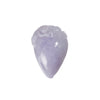
Jade Gourd
Jade Gourd, also referred to as Lucky Gourd is an umbrella term for several jade pendant designs which includes: Hulu and Fortune Melon. Their meanings generally convey the same symbols of prosperity and good fortune. Wearing a jade gourd pendant is said to bring prosperity and good fortune.
| Symbolism: | Prosperity and Good Fortune |
| Benefits: | Brings prosperity and good fortune |
| Cultural Context: | Chinese |
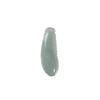
Jade Tlaloc
Tlaloc is a significant deity in Aztec mythology, associated with rain, water, fertility, and agriculture. Deities in many mythologies are often seen as intermediaries between humans and the spiritual realm. Wearing a jade Tlaloc pendant may be a way to express a spiritual connection or seek blessings related to water and fertility.
| Symbolism: | Weather, Fertility |
| Benefits: | Bring blessings for a bountiful harvest and prosperity |
| Cultural Context: | Aztec, Mexican |
Jade Niho (Tooth)
he term "niho" itself is derived from the Māori language, where it means "tooth" or "teeth". The specific design and meaning of niho pendants can vary, and they may carry different symbolism based on the carver's intentions or the wearer's cultural context. In general these a jade niho pendant represents aspects such as strength, protection, and connection to ancestry.
| Symbolism: | Strength, Protection |
| Benefits: | Brings a connection to ancestry |
| Cultural Context: | Maori |
Jade Laughing Buddha
The Laughing Buddha, also known as Budai or Hotei, is a revered figure in East Asian folklore and Buddhism, symbolizing good luck, abundance, and prosperity. Wearing a Laughing Buddha jade pendant is believed to attract positive energies, bringing not only good fortune but also financial well-being. Portrayed as a content and satisfied figure, Budai represents the pursuit of contentment and fulfillment in life, emphasizing the importance of appreciating what one has. According to folklore, rubbing the belly of the Laughing Buddha is thought to bring joy and dispel worries, making a Jade Laughing Buddha pendant a symbolic talisman for alleviating stress and anxieties. In Japanese mythology, the Laughing Buddha is affectionately known as the "Hotei who laughs", highlighting the gift of laughter. Choosing to wear a Jade Laughing Buddha pendant becomes a lighthearted and playful choice, promoting joy and humor in one's life.
| Symbolism: | Good Luck, Happiness and Joy, Fulfillment |
| Benefits: | Alleviate stress and anxieties and attract luck and positive energies |
| Cultural Context: | East Asian |
Jade Twist (Pikorua)
The Twist, or Pikorua, is a traditional Maori symbol characterized by its intertwined and looping form. The intertwining loops represent the concept of an eternal bond or connection between individuals. It symbolizes the interconnectedness of relationships, whether it be between family members, friends, or partners. Often the looping pattern is also associated with the cycles of life, including birth, growth, and regeneration. Wearing a Twist pendant can symbolize an appreciation for the cyclical nature of existence and the ongoing journey of personal and spiritual growth.
| Symbolism: | Eternal Bond, Cycles of Life |
| Benefits: | Brings togetherness; maintaining balance in relationships and a sense of unity |
| Cultural Context: | Maori |
Jade Koru (Spiral)
The Koru, or spiral, is a prominent symbol in Maori culture, representing new life, growth, and renewal. Its spiral shape is inspired by the unfurling fern frond, a native plant in New Zealand. The Koru is widely recognized as a symbol of new beginnings, growth, and transformation. Wearing a Jade Koru pendant can signify a fresh start in life, embracing new opportunities, and embarking on a journey of personal growth and renewal.
| Symbolism: | New Beginnings, Renewal, Hope |
| Benefits: | Promotes a fresh start, embracing new opportunities, and embarking on a journey of personal growth and renewal |
| Cultural Context: | Maori |
Jade Donut
The jade donut is similar to a jade disc, it often describes a round, disc-shaped jade pendant with a central hole, resembling a donut. In some cases, the central hole may be large or small, and the overall design may vary. The continuous loop of the donut form can represent eternity and infinity. It symbolizes the cyclical nature of life, the unending flow of energy, and the interconnectedness of all things. The circular shape of the jade donut represents unity, harmony, and balance. Wearing a jade donut pendant may symbolize the pursuit of equilibrium in various aspects of life, fostering a sense of completeness and interconnectedness.
| Symbolism: | Eternity and Infinity, Equilibrium |
| Benefits: | Brings a sense of completeness and interconnectedness |
| Cultural Context: | Chinese |
Jade Corn
Wearing a jade corn pendant carries rich symbolism in Chinese culture, intertwining the auspicious qualities of both jade and the symbolic significance of corn. As a single corn contains numerous kernels, corn has traditionally been associated with auspicious meanings such as abundant wealth, numerous offspring, thriving business, and perennial peace. The golden jade corn pendant is believed to have the power to attract and enhance prosperous business endeavors, making it a meaningful charm for individuals seeking financial success. Corn symbolism goes beyond mere agricultural representation; it encapsulates the ideas of gathering and the successful harvesting of wealth and opportunities, promising abundance in various aspects of life. Wearing a jade corn pendant becomes not only a nod to agricultural abundance but a potent emblem of prosperity, fertility, and the bountiful gathering of positive energies and opportunities.
| Symbolism: | Prosperity, Abundance, Fertility, Peace |
| Benefits: | Brings abundance in various aspects of life |
| Cultural Context: | Chinese |

Jade Landscape (Shanshui)
The meaning of a jade landscape pendant is to invite abundant wealth, foster an open-minded attitude, and embrace a carefree and liberated spirit. If the jade landscape pendant is carved with layered springs or waterfalls, it signifies a long and prosperous source, the ability to find success in various directions, and a continuous flow of wealth. If the carving includes water pools, it implies a gathering of treasures, and if boats are present, all boats are oriented inward, symbolizing smooth and favorable journeys ahead. Wearing a jade landscape pendant also expresses the wish for the wearer to possess a compassionate and wise heart, along with a broad and open-minded attitude, facing both the positives and negatives of life with a smile. Furthermore, wearing a jade landscape pendant represents an aspiration for a beautiful and comfortable life and a pursuit of a carefree state of mind.
| Symbolism: | Liberated Spirit, Open-minded Attitude |
| Benefits: | Promotes open-mindedness and a beautiful and comfortable life |
| Cultural Context: | Chinese |
Jade Ruyi
The jade Ruyi pendant holds significant meaning in Chinese culture. The Ruyi, originally a ceremonial scepter, has evolved into a symbol of authority, good fortune, and prosperity. The term "Ruyi" translates to "as you wish" or "in accordance with your desires," suggesting fulfillment of one's wishes. Wearing the jade Ruyi pendant may be seen as a way to attract positive energy and realize one's aspirations.
| Symbolism: | Power, Wish Fulfillment |
| Benefits: | Promotes actualization of one's wishes and dreams |
| Cultural Context: | Chinese |
Jade Fortune Melon
Fortune Melon also known as Blessed Melon has various meanings depending on the type of melon carved on the pendant such as: winter melon, pumpkin and chayote. In general, the Chinese word for Fortune Melon, “福瓜” (Fú Guā), has a phonetic resemblance to the phrase "福挂" (Fú Guà) which can be interpreted as "Hanging Prosperity" or "Hanging Good Fortune". This linguistic association suggests that wearing (hanging) a Jade Fortune Melon pendant is to the same effect as hanging good fortune.
| Symbolism: | Good Fortune |
| Benefits: | Brings happiness and good fortune |
| Cultural Context: | Chinese |
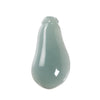
Jade Manaia
A manaia is a mythical creature and a common motif in Māori art and carvings. It is characterized by a composite form that often combines elements of human, bird, and fish forms. The manaia is typically depicted with the head of a bird, the body of a human, and the tail of a fish. The manaia is often seen as a guardian spirit and a protector. It is believed to watch over individuals, communities, and the natural world, offering guidance and safeguarding against harm. The composite nature of the manaia, combining elements of different creatures, represents a harmonious balance in nature and life.
| Symbolism: | Protection, Harmony |
| Benefits: | Brings harmony and protection |
| Cultural Context: | Maori |

WAI YAN

